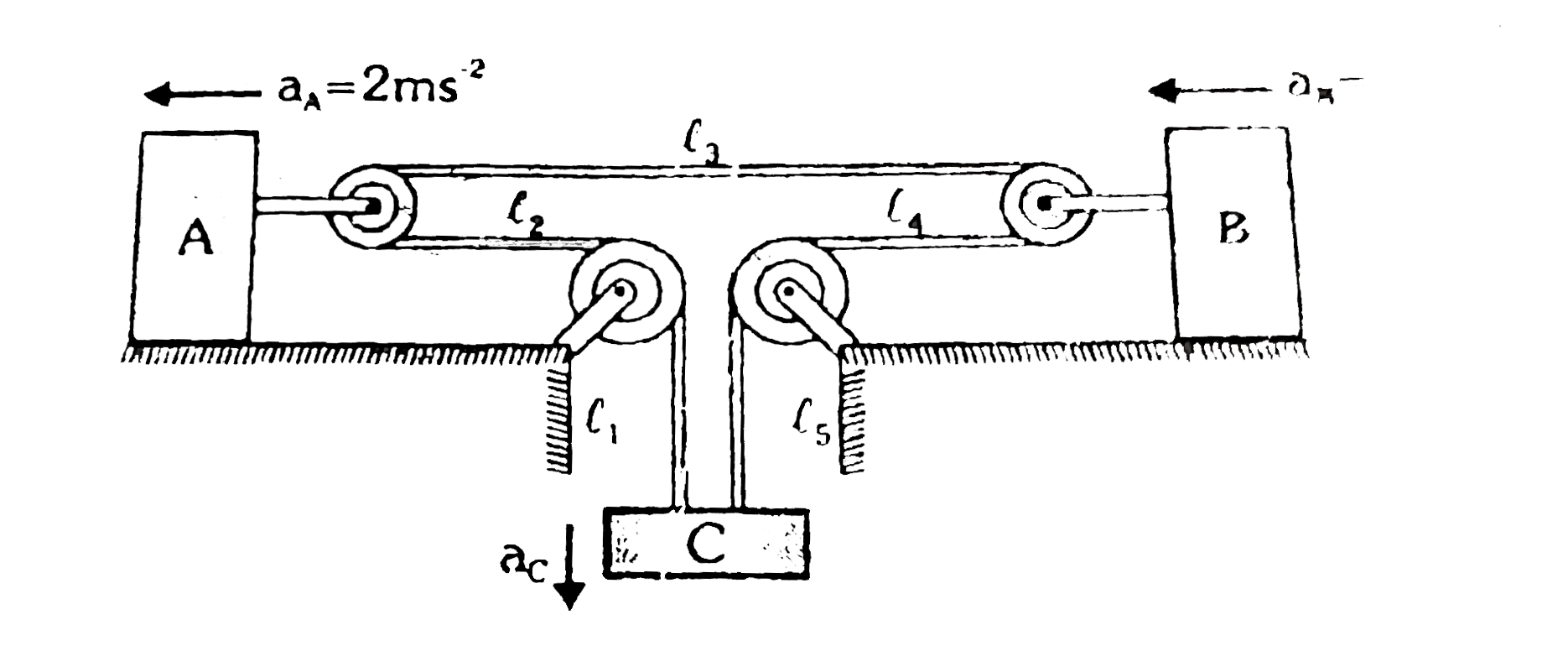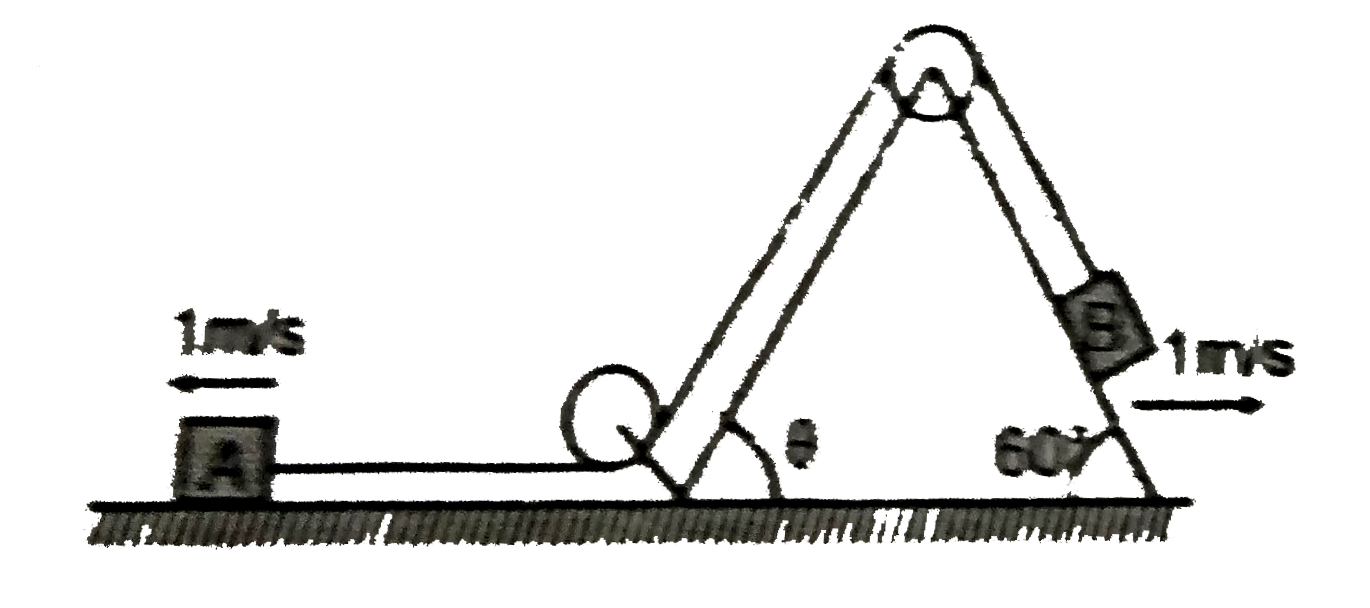If accelration of A is 2m/s2 towards left and accleration of B is 1m/s2 towards left, then accleration of C is:
 Solution in Gujrati
Solution in Gujrati
1m/s2 downwards
1m/s2 upwards
2m/s2 downwards
2m/s2 upwards
The correct Answer is:B

l1+l2+l3+l4+l5= constant
⇒..l1+..l2+..l3+..l4+..l5=0
⇒aC+aA+(aA−aB)+(−aB)+aC=0
⇒2aC+2aA−2aB=0
⇒aC=aB−aA=1−2=−1ms−2
⇒ Acceleration of C is 1ms−2 upwards
Topper's Solved these Questions
- KINEMATICSBOOK - ALLEN CHAPTER - KINEMATICSEXERCISE - EXERCISE-02
57 Videos
- KINEMATICSBOOK - ALLEN CHAPTER - KINEMATICSEXERCISE - EXERCISE-03
6 Videos
- KINEMATICSBOOK - ALLEN CHAPTER - KINEMATICSEXERCISE - EXERCISE-2
89 Videos
- ERROR AND MEASUREMENTBOOK - ALLEN CHAPTER - ERROR AND MEASUREMENTEXERCISE - Part-2(Exercise-2)(B)
22 Videos
- KINEMATICS (MOTION ALONG A STRAIGHT LINE AND MOTION IN A PLANE)BOOK - ALLEN CHAPTER - KINEMATICS (MOTION ALONG A STRAIGHT LINE AND MOTION IN A PLANE)EXERCISE - BEGINNER S BOX-7
8 Videos
Similar Questions
A particle is moving in a plane with velocity given by →u=u0ˆi+(aωcosωt)ˆj, where ˆi and ˆj are unit vectors along x and y axes respectively. If particle is at the origin at t=0. Calculate the trajectory of the particle :-
View SolutionThe equation of one dimensional motion of the particle is described in column I. At t=0, particle is at origin and at rest. Match the column I with the statement in Column II.
Column IColumn II(A)x=(3t2+2)m(p)Velocity of particle at t=1s is 8m/s(B)v=8tm/s(q)Particle moves with uniform acceleration(C)a=16t(r)Particle moves with variable acceleration(D)v=6t−3t2(s)Particle will change its direction some time
View SolutionA student performs an experiment to determine how the range of a ball depends on the velocity with which it is projected. The "range" is the distance between the points where the ball lends and from where it was projected, assuming it lands at the same height from which it was projected. It each trial, the student uses the same baseball, and launches it at the same angle. Table shows the experimental results.
∣∣ ∣ ∣ ∣ ∣ ∣∣TrailLaunch speed(m/s)Range(m)110822031.833070.7440122.5∣∣ ∣ ∣ ∣ ∣ ∣∣
Based on this data, the student then hypothesizes that the range, R, depends on the initial speed v0 according to the following equation : R=Cvn0, where C is a constant and n is another constant.
Based on this data, the best guess for the value of n is :-
View SolutionA cube has a side of length 1.2×10−2m. Calculate its volume.
View SolutionA football player kicks a ball at an angle of 30∘ with an initial speed of 20 m/s. Assuming that the ball travels in a vertical plane, calculate (a) the time at which the ball reaches the highest point (b) the maximum height reached (c) the horizontal range of the ball (d) the time for which the ball is in the air, (g=10m/s2)
View SolutionSystem is shown in fig. and wedge is moving toward left with speed 2ms^(-1) . Find the velocity of the block B.
View SolutionIf acceleration of A is 2m/s2 to left and acceleration of B is 1m/s2 to left, then acceleration of C is-

View SolutionA system is shown in the figure. Block A is moving with 1m/s towards left. Wedge is moving with 1m/s towards right. Then speed of the block B will be :

View SolutionA mass of 1kg is suspended by a thread. It is
1. lifted up with an accleration 4.9m/s2.
2. lowered with an acceleration 4.9 m/s2.
The ratio of the tensions is
View SolutionThe accleration of a particle as seen from two frames S1 and S2 have equal magnitudes 4 m/s2
View SolutionA simple pendulum is suspended from the ceilling of a left. When the lift is at rest, its time period is T . With what accleration should lift be acclerated upwards in order to reduce its time period to (T)/(2) .
View Solution(180 In the figure shown the initial velocity of boat plus person is 2 m/s. Find velocity of person w.r.t. boat so that velocity of boat will be 1 m/s in right. 15 kg 30 kg 2 m/s 3 m/s towards right 3 m/s towards left 4 m/s towards right 4 m/s towards left
View SolutionThe accleration of a particle as seen from two frames S1 and S2 have equal magnitudes 4 m/s2
View SolutionAn object moves width 5m/s towards right while the mirror moves 1m/s towards the left as shown. Then the velocity of image is

View SolutionA का बायी ओर त्वरण 2m/s2 है एवं B का बायी ओर त्वरण 1m/s2 है। C का त्वरण होगा

View SolutionA simple pendulum is suspended from the ceilling of a left. When the lift is at rest, its time period is T. With what accleration should lift be acclerated upwards in order to reduce its time period to T2.
View Solution
